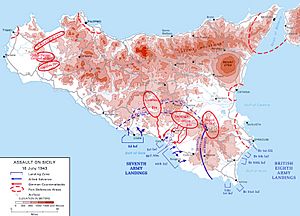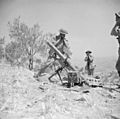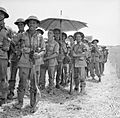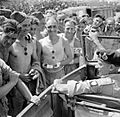Allied invasion of Sicily facts for kids
Quick facts for kids Sicilian Campaign |
|||||||
|---|---|---|---|---|---|---|---|
| Part of the Italian Campaign of World War II | |||||||
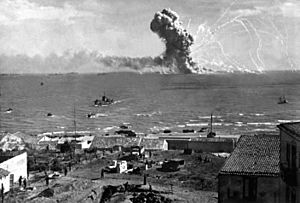 The U.S. Liberty ship Robert Rowan explodes after being hit by a German bomber off Gela, Sicily, 11 July 1943 |
|||||||
|
|||||||
| Belligerents | |||||||
|
|
Axis: |
||||||
| Commanders and leaders | |||||||
| Strength | |||||||
| Initial Strength: 160,000 personnel 14,000 vehicles 600 tanks 1,800 guns Peak Strength: 467,000 personnel |
230,000 Italian personnel 40,000 - 60,000 German personnel 260 tanks 1,400 aircraft |
||||||
| Casualties and losses | |||||||
| 24,850 casualties (5,837 killed or missing, 15,683 wounded, 3,330 captured) |
~20,000 casualties 131,359-147,000 killed, wounded and captured (mainly POWs) |
||||||
The Allied invasion of Sicily was code-named Operation Husky. It was a major battle of World War II. The Allies captured Sicily from the Axis Powers (Italy and Nazi Germany).
It was a big sea and air operation, followed by six weeks of land fighting. It started the Italian Campaign. It was followed by the Allied invasion of Italy.
Husky began on the night of 9–10 July 1943, and ended 17 August. Husky achieved the goals of the Allies. The Allies removed Axis air, land and naval forces from the island.
As well, the Mediterranean's sea lanes were opened to the Allies, and Italian dictator Benito Mussolini was briefly removed from power.
Contents
Background
Allies
The plan for Operation Husky called for the sea attack of the island by two armies. One would land on the South Eastern coast. Another would land on the central Southern Coast. The attack would be helped by naval gunfire and bombing. The commander was the American General Dwight D. Eisenhower.
The Allied land forces were from the American, British and Canadian armies. They were put into two groups. The Eastern Task Force was led by General Bernard Montgomery. The Western Task Force was commanded by Lieutenant General George S. Patton. In addition to the sea landings, airborne troops were to be flown in. They would capture bridges and high ground.
The Allied naval forces were put into two groups to transport the invading armies.
The island was defended by the two corps of Italian 6th Army under General Alfredo Guzzoni. In early July the total Axis force in Sicily was about 200,000 Italian and 32,000 German troops, and 30,000 Luftwaffe ground staff. By late July there were 70,000 German troops.
Planning
The attack plan was made on 17 May. At the Casablanca Conference in January 1943, political leaders and the military leaders of the US and Britain met to discuss future plans. The British wanted an invasion of Sicily. General Eisenhower was made Commander-in-Chief of the Allied Forces.
Preparatory operations
Once the Axis forces had been defeated in Tunisia, the Allied bombers attacked the airfields of Sardinia, Sicily and southern Italy. They also bombed industrial targets in southern Italy and the ports of Naples, Messina, Palermo and Cagliari.
Deception
To distract the Axis, the Allies did several trick operations. The most famous was Operation Mincemeat. The British allowed a corpse disguised as a British officer to drift ashore in Spain, carrying a briefcase with fake secret documents.
These stated that the Allies were planning to invade Greece and Sardinia, and had no plans to invade Sicily. The Germans thought the documents were real. The Germans moved much of their defences from Sicily to Greece.
Battle
Two British and two American attacks by airborne forces were done on the night of 9–10 July. They wanted to capture the bridge over the River Anape. Strong wind made them land in the wrong places. Airborne troops attacked patrols. A platoon captured the bridge and fought off counterattacks for a few hours.
The strong winds made the sea landings hard. Landings were made on 10 July on twenty-six main beaches.
By the evening of 10 July the seven Allied divisions were ashore and the port of Syracuse had been captured.
Alexander's plan was to establish his forces on a line between Licata in and Catania. He wanted to capture ports.
Images for kids
-
Allied leaders in the Sicilian campaign. General Dwight D. Eisenhower meets in North Africa with (foreground, left to right): Air Chief Marshal Sir Arthur Tedder, General Sir Harold Alexander, Admiral Sir Andrew Cunningham, and (top row): Mr. Harold Macmillan, Major General Walter Bedell Smith, and unidentified British officers.
-
British troops of the 6th Battalion, Durham Light Infantry, part of the British 50th Division, with an American paratrooper of the 505th Parachute Infantry Regiment, part of the U.S. 82nd Airborne Division, in Avola, 11 July 1943
-
Italian soldiers of the 206th Coastal Division, taken prisoner by British forces. Typical of the second-rate equipment issued to the Coastal divisions, they are wearing Adrian helmets of World War I vintage, rather than the more modern M 33.
-
Sherman tank of the 3rd County of London Yeomanry (Sharpshooters) in the village of Belpasso near Catania, Sicily, August 1943
-
Men of the 6th Battalion, Royal Inniskilling Fusiliers, British 78th Division, await orders to move into Centuripe, Sicily, 2 August 1943.
-
General Montgomery stops his car to talk to men of the Royal Engineers working on a road near Catania, Sicily, August 1943.
See also
 In Spanish: Invasión aliada de Sicilia para niños
In Spanish: Invasión aliada de Sicilia para niños


